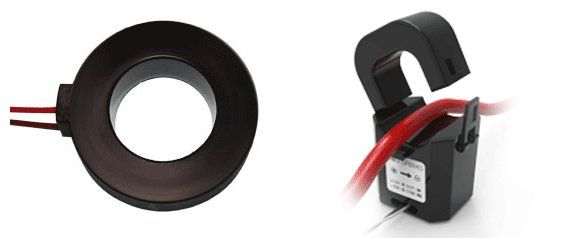What Are Current Transducers?
Current transducers, also known as current sensors, are electrical devices that have an essential role in measuring and monitoring the flow of electrical current within a circuit. They find application in various areas such as energy management, power quality analysis, and equipment protection.

By safely and efficiently gathering data on current levels, these devices enable engineers and technicians to make well-informed decisions regarding electrical systems.
Split-Core Current Transducers
Introduction to Split-Core Transducers
Split-core current transducers are widely favored in the industry due to their convenient installation and retrofitting capabilities. The transducers feature a split in the core, allowing them to be easily clamped around existing conductors without disconnecting any wires. This unique characteristic makes them especially suitable for applications where minimizing downtime is crucial.
How Split-Core Transducers Work
In split-core transducers, a magnetic core surrounds the current-carrying conductor. As electricity passes through the conductor, it generates a magnetic field.
The transducer measures the strength of this magnetic field, which is directly proportionate to the amount of current flowing through the conductor. This measured data is then transformed into an electrical signal that can be effectively utilized.
Applications of Split-Core Transducers
Split-core current transducers find applications in various industries, including:
- Building automation systems
- Energy submetering
- Power quality analysis
- Motor monitoring
- HVAC systems
- Lighting control
Solid-Core Current Transducers
Introduction to Solid-Core Transducers
Solid-core current transducers, as their name implies, consist of a continuous and unbroken core. In contrast to split-core transducers, solid-core ones require the circuit to be disconnected during the installation process. Although this might be less convenient, utilizing solid-core transducers provides distinct advantages in terms of accuracy and precision.
How Solid-Core Transducers Work
Solid-core transducers and split-core transducers operate similarly, both relying on the magnetic field produced by the current. However, solid-core transducers have a design where their core is solid, ensuring a more consistent magnetic coupling and ultimately providing higher accuracy readings.
Applications of Solid-Core Transducers
Solid-core current transducers find common use in applications where precision is of utmost importance. Examples include:
- Power distribution systems
- Electrical substations
- High-accuracy power meters
- Renewable energy systems
- Industrial machinery monitoring
Key Differences Between Split-Core and Solid-Core Transducers
Size and Installation
In terms of ease of installation and retrofitting, split-core transducers emerge as the preferred choice due to their convenience. They enable quick and hassle-free installations, unlike solid-core transducers which necessitate circuit disconnection and are more time-consuming.
Accuracy and Sensitivity
Solid-core transducers offer higher accuracy and sensitivity due to their unbroken core design. On the other hand, split-core transducers, though slightly less accurate, still prove suitable for various applications.
Compatibility and Versatility
Split-core transducers offer versatility and find application across a wide range of uses. On the other hand, solid-core transducers prioritize accuracy and excel in specific high-precision scenarios.
Why Should You Care About Current Transducers?
Importance in Energy Management
In today's world, proper energy management holds utmost importance. The utilization of current transducers is instrumental in optimizing energy consumption, minimizing wastage, and reducing costs.
Enhanced Safety Measures
Accurate monitoring of current sensor is essential for ensuring the safety of electrical systems. It not only helps prevent overheating, electrical faults, and potential fires but also minimizes the associated risks.
Compliance with Regulations
Many industries and regions have implemented regulations that mandate accurate monitoring of current. By utilizing current transducers, individuals can ensure compliance with these standards.
Choosing the Right Current Transducer for Your Needs
When one is choosing a current transducer, it is important to take into account various factors. These include the desired current range, accuracy requirements, installation limitations, and budgetary considerations. It is crucial to avoid common errors such as using a transducer with a mismatched current rating for your specific application.
Installation and Maintenance Tips
To ensure accurate readings, proper installation is crucial. Additionally, regular maintenance guarantees optimal performance of the transducer throughout its lifespan.
Real-Life Examples
Witness how various industries reap the benefits of utilizing current transducers through a collection of enlightening case studies.
Future Trends in Current Transducers
To keep yourself informed about the latest technological advancements in current transducers, including innovations like wireless communication and enhanced accuracy, stay updated.
FAQs
1) What is the lifespan of a typical current transducer?
The lifespan of a current transducer is influenced by various factors, including usage, environmental conditions, and quality. On average, a properly maintained transducer can endure for approximately 10 to 20 years.
2) Are there wireless current transducer options available?
There are wireless current transducers available that offer remote monitoring capabilities. These transducers are particularly suitable for applications where wired connections may not be practical.
Conclusion
In conclusion, current transducers are essential instruments in the field of electrical engineering and energy management. They plays a crucial role in optimizing energy usage, enhancing safety, and ensuring regulatory compliance. By selecting the appropriate transducer for your specific needs and following proper installation and maintenance procedures, you can fully harness the potential of these devices.
You Might Also Like: Current Sensor : Working, Interfacing & Its Applications








